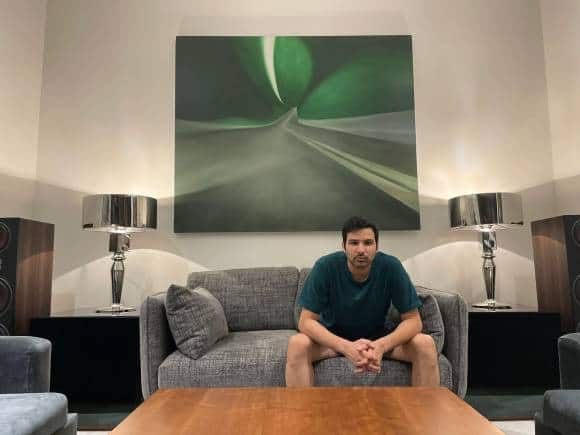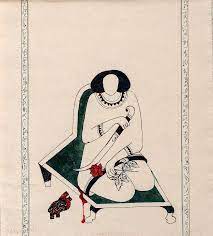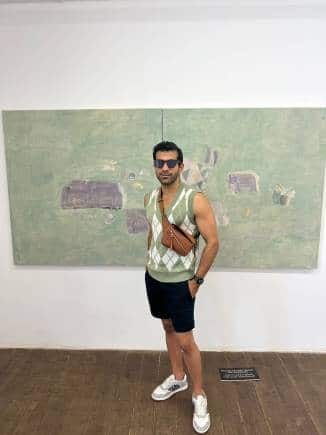



Sanuj Birla’s Birkin Drip is a dazzling riff on the epitome of high fashion yen, the Birkin Bag. This chrome-plated, resin-and-fibreglass sculpture has a reflective surface and adapts to light. In refulgent silver, under the spotlight at Designera, Mumbai’s first and only art gallery dedicated to the convenient umbrella term “pop art”, the work lives up to the diva status of its inspiration. Designera prices it at Rs 1.45 lakh — safely under the rubric of affordable art. Designera, founded by Amrita Arora, is the next addition to the city’s changing art destinations after Sahil Arora’s Method, which is also dedicated to urban, street and contemporary art by emerging artists from around the world. Method recently opened a second and then a third suburban venue.
 'Brikin Drip' by Sanuj Birla at Designera, in Mumbai.
'Brikin Drip' by Sanuj Birla at Designera, in Mumbai.Birla suffuses Birkin Drip with anamorphic chrome, and it is distinctly surreal in feel compared to the clear, seamless lines and texture of the painting Birla, a Delhi-based millennial artist, is most famous for: Marvel-ous Last Supper, a 100-by-36 inches mixed media work on canvas (Rs 4.65 lakh). Birla reimagines Leonardo da Vinci’s Last Supper and populates the canvas with Batman, Superman, Spider-Man, Wonder Woman, Iron Man, the Hulk, Captain America, the Monalisa, Van High’s Starry Nights and Italian Renaissance painting motifs in one rollicking mash-up. The superheroes, dressed in Victorian neck cuffs and other such accessories and cuts, look defiant — and strangely at ease. Birla isn’t going for the jocular or the ironic here; he is just juxtaposing — an act of artistic supplanting. In another painting, The Museum Mashup, Birla depicts a surreal museum scene, where the disruptors, lying carelessly about, include Warholian Marilyn Monroe prints, Mickey Mouse, Charlie Chaplin, animals like hens and zebras, and a soaring astronaut on the ceiling.
Designera, which recently opened at the heart of Lower Parel’s Raghuvanshi Mills, is showcasing Birla and several other pop artists — Yogesh Lokhande, Gayatri Sekhri, Vijay Shinde, Pranish Mhatre, Bhushan Vaidya, Vijay Wadekar. They also sell art through their website.
 'Soup Spills and Sunflowers' by Amara De Tori, on display at Designera, Mumbai.
'Soup Spills and Sunflowers' by Amara De Tori, on display at Designera, Mumbai.Designera’s launch almost coincided with the coming of the Toiletpaper Magazine exhibition at the Nita Mukesh Ambani Cultural Centre (NMACC) — a spectacular pop art sprawl (see our review here). The term ‘pop art’ is often loosely used. In the art world, it essentially refers to art based on modern popular culture, especially as a critical or ironic comment on traditional fine art values. Ever since both exhibitions opened, both shows are seeing remarkable footfall. “Our collectors or even just walk-in visitors are largely in the age-group of 20 to 40, but we are also seeing 50- and 60-plus art lovers and collectors who come in with their children and are introduced to a whole new aesthetic,” says Jishnu Gupta, curator at Designera.
Even in 2023, an overwhelming majority of serious collectors interested in acquiring Indian art look for the Moderns like MF Husain, SH Raza, Tyeb Mehta, VS Gaitonde and others. The Moderns still fetch the highest bids at international and domestic auctions. Contemporary art has a variety of platforms and connoisseurs now, and an increasing number of buyers are millennials. Ranjana Steinreucke, who runs Galerie Mirchandani + Steinreucke, a space that has launched and nurtured several contemporary artists from across India, at Ballard Estate, Mumbai, says, “There are more Indians under 30 who are visiting the gallery and also acquiring art. I think they get interested through social media, and also of course through friends and peers. The numbers aren’t very large but it’s definitely a growing segment. Younger galleries entering the field play a role, and we need more of those in Mumbai, as well as alternate art spaces.”
The India Art Fair this year had a young collectors’ weekend. It included works from Method and other galleries and collections that have created a space for new age and digital art which has never been showcased at traditional galleries. Neal Sekhri, a Delhi-based 34-year-old collector says, “The IAF young collectors’ weekend was exciting. It showcased over 50 young Indian contemporary artists to a young audience in a fun and light way. We had a great time.”
 Delhi-based art collector Neal Sekhri with Divya Singh's painting 'Nox Umbra / Fallen Angels' on the wall behind him.
Delhi-based art collector Neal Sekhri with Divya Singh's painting 'Nox Umbra / Fallen Angels' on the wall behind him. Sekhri is part of a music production and DJ duo called MadStarBase. His childhood friend Anant Ahuja, 33, is the band’s other part. Both completed undergraduate studies in the US and upon returning to India, formed MadStarBase.
For collectors in Sekhri’s age group, art isn’t a singular passion, which they adopted one fine day. He says his interest in art was “like a natural outcome of growing up, and being a part of an explosive burst of creativity in the underground music scene. Music led him to explore other forms of art in India, and as he went deeper into the world of art, his interest solidified. “Then I wanted to start hanging some of the art I was looking at in my home,” Sekhri says. He and his wife started collecting art in 2022, and they already own about 15 works of art, which includes “a couple of Kunel Gaur pieces from his Information Architecture show, an exquisite Divya Singh titled Nox Umbra / Fallen Angels, an amazing wall sculpture by J Demsky from the show he recently did with Method Gallery from Mumbai, a beautiful sculpture by Gurjeet Singh, and an epic behind-the-scenes photo from the set of a Bollywood film from 1938 shot by Josef Wirsching.” They also commissioned a huge wall mural/etching by Nischay Thakur. They also own three works by Arshi Irshad Ahmadzai.
 A work by Arshi Irshad Ahmadzai.
A work by Arshi Irshad Ahmadzai.Sekhri has no desire to buy the Moderns. Their collecting philosophy is “unearthing hidden gems”. “We want to highlight and showcase the real raw talent in this country, and the stories behind these artists and their art are so rich and vibrant too. It’s in this boundary, at the edges of mainstream art, where you can find something truly spectacular that lots of people may not know about,” Sekhri says. He looks for triggers to feeling something — a rule that art collectors of all generations live by. Sekhri believes Indians below 40 and below 30 want to be art collectors but the traditional art world is too expensive and “too exclusive a club to enter”. “That’s why there is a need and latent desire for art that is accessible, art that is presented in a more exciting and fun way. This allows new, young, potential collectors to get involved without feeling intimidated,” Sekhri adds.
Kunal Sood, another Delhi-based collector, also 34, was co-founder of a med-tech start-up Smart Medical Buyer until 2022 when it was sold. He rejoined his family’s real-estate business, Sood & Sood Builders as director.
 Delhi-based art collector Kunal Sood.
Delhi-based art collector Kunal Sood.Sood’s interest in art began when he was studying in London. He visited the National Portrait Gallery and the Tate modern many times over. “The complete contrast between the two was fascinating to me and also the fact that both forms of art kind of appealed to me drew me to learn more about various forms, media and of course, the fascinating lives of artists,” Sood says. Several reports on collectors in their 20s and 30s that have come out since 2019 conclude that a huge majority of collectors in their 20s and 30s needed “emotional benefits or passion for art” as their chief incentive for buying. They are drawn to artists who address social issues, cultural diversity, and environmental concerns. Experienced gallerists in Mumbai and Kolkata say that they value art as a social and cultural currency. Art events, gallery openings, and artist talks are not only opportunities to appreciate artwork but also to network, collaborate, and exchange ideas with other art enthusiasts. Millennials see art as a catalyst for social interaction and a platform for cultural dialogue.
Sood started collecting art around 2018, and owns close to 70 artworks, which includes an untitled Sohan Qadri, Biraaj Dodiya’s Day Sleeper, Bharat Sikka’s Waiting for Midnight and Rathin Barman’s triptych Transitory Spaces. He owns sculptures by Vinita Mungi and Vibha Galhotra.
He says he is most drawn to young artists experimenting with new media, as well as works that fall under the pop art category. Like Sekhri, Sood believes that his investment criteria for art is strictly emotionally-driven. “If it’s an artwork I’d like to see over and over again, I am very keen to acquire it.
In order to make sound decisions from an investment perspective I have tried to surround myself with colleagues, curators and collectors that have similar tastes and know a lot more than me," he says. His latest big purchase is an untitled work by Sohan Qadri, for around Rs 10 lakh. “I don’t think I’ve gone beyond Rs 15-20 lakh for a single artwork in my collection so far.”
Over the past decade, many consumer behaviour studies have concluded that millennials have a large appetite for self-improvement and informal learning, and it applies to their approach to investing in art. “I think the exposure to all the beautiful art can only be good for everyone — makes you think, question and reflect. There is a sense of exclusivity that has always been synonymous with the art world. This IYKYK (If You Know You Know) kind of attitude only adds to appeal of being part of the Indian art scene but I’m sure is not the only reason for a rise in young collectors,” Sood says.
 Chandigarh-based artist Gurjeet Singh with his work.
Chandigarh-based artist Gurjeet Singh with his work.An artist that’s emerging as a favourite among new collectors is prolific Chandigarh-based artist Gurjeet Singh known for his weird and zany interpretations of Indian figures and faces through “soft sculptures” — not small that they could be toys; they’re more like toy whoppers. This is What It’s Like to Be Fabulous was an apt title for Singh’s first solo show at Mumbai’s Chemould CoLab — an extension of Chemould Prescott Road gallery that supports emerging artists — in November-December, 2022. Singh’s works in that show candid boy-meets-boy scenes in rural India extending over to his own struggles with sexuality. Singh’s art has a singularly pop take on gender fluidity and it has something substantial to say about patriarchy, and about that overused qualifier that’s now part of social media exchanges as well as café conversations among millennials: “toxic masculinity".
 Atyaan Jungwaala with mother Shireen Gandhy at Chemould Colabs, Mumbai.
Atyaan Jungwaala with mother Shireen Gandhy at Chemould Colabs, Mumbai.The co-founder and head of Chemould CoLab is Atyaan Jungalwa. As a third-generation gallerist of the Gandhy family behind the Chemould art gallery (read a review of a book on the Gandhys of Chemould here). She is the daughter of Shireen Gandhy, who runs the prestigious Chemould Prescott-Road. Educated in Design, Atyaan is passionate about exhibition and spatial design and aims to blur the boundaries between Art and Design. Atyaan is also an art advisor for first-time and young collectors. At Chemould CoLab, she is currently building a wider creative community through collaborations with designers from various fields.
Chemould CoLab shows push the boundaries of contemporary art today through an annual summer residency programme for artists, workshops and talks. They’ve so far hosted residencies for artists Gurjeet Singh, Rithika Pandey and Tarini Sethi. This is Chemould’s 60th year, and to commemorate, Atyaan has invited invited young artists to respond to artists who are a part of the current Chemould Prescott Road stable of artists. “Creating these intersections, our young artists have been given prompts that will nudge, provoke and create new conversations,” Atyaan says.
She helps first time collectors understand the vision of building a collection and give them a chance to follow an artist’s practice from the very beginning. Through her open studio events during the residency, young enthusiasts and collectors interact with artists and see their work in progress.
“Mostly, first time collectors find it easy to purchase drawings/works on paper or smaller canvases that can be easily put onto a wall. While fewer collectors lean to buying sculptural pieces or works that talk of bolder themes,” Atyaan says. Artists on her radar: Divya Cowasji, Shailee Mehta, Maksood Mondal, Tarini Sethi and Viraj Khanna.
The new art-going audience in the city is impossible to miss if you visit art galleries often. Art Night Thursday, a weekly summer event (borrowed from the original in London) when in the art district spanning Fort to Colaba galleries and museums extend their opening hours on the first Thursday of every month, is a new addition to the social calendars of Gen-Z. The niche pursuit of experiencing good art has stepped beyond rarefied realms of white cube galleries. Art is finally also for the average aesthete who don’t need to know the full story of pop art’s becoming — a reactionary offshoot of European abstract expressionism going back to 1940s’ and 1950s’ America.
Discover the latest Business News, Sensex, and Nifty updates. Obtain Personal Finance insights, tax queries, and expert opinions on Moneycontrol or download the Moneycontrol App to stay updated!
Find the best of Al News in one place, specially curated for you every weekend.
Stay on top of the latest tech trends and biggest startup news.